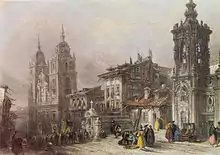Noviciado de la Compañía de Jesús (Madrid)
The Noviciado de la Compañía de Jesús (Spanish for: Novitiate of the Society of Jesus), was once the largest church in Madrid. It was located on Calle Ancha de San Bernardo, where currently stands the mansion of the former Central University, now called Complutense University of Madrid. The church, in the Baroque style, was founded on April 15, 1602, based on an initiative of Ana Félix de Guzmán (1560-1612) Marquise of Camarasa. Placed under the patronage of Saint Ignatius confessor of Loyola, its plant was a Latin cross, with a transept of good size. The exterior of the main facade consisted of a central body flanked by two towers. On the central body was placed a shield with the Royal arms carved by Felipe de Castro. Attached to the church, and toward the Calle de los Reyes, stood the rest of the complex, which was not built until mid-century. In 1767, the Jesuits were expelled and the Casa del Noviciado was ceded by the king to the Venerable Congregation of Priests Missionaries of the Savior of the world, taking the name of the Oratorio de los Padres del Salvador del Mundo. Today, little of the Novitiate House remains. The perimeter walls of the church survive, used for building the paraninfo of the university. The rest of the complex is preserved in two ancient cloisters, converted into courtyards, around which the various offices and classrooms are distributed.

History
Early history and construction

The Noviciado de la Compañía de Jesús was founded on April 15, 1602, based on an initiative of Ana Félix de Guzmán (1560-1612) Marquise of Camarasa. This made available to the Jesuits some land recently acquired, occupied almost all of the block between the present calles de San Bernardo, Noviciado, Amaniel and Reyes. On this farm it had been the Embassy of Genoa, which had been abandoned in 1601, after the brief moving of the Court from Madrid to Valladolid, by decision of Philip III (d. 1598-1621). In 1605 began the construction of the church, which occupied the northern end of the property. Attached to it and toward the Calle de los Reyes, stood the rest of the complex, although its works could not begin until mid-century.
Of the building, the most notable was the church, built around 1606 according to the plans of Jesuit architect Pedro Sánchez, who had also made the Iglesia del Colegio Imperial. Placed under the patronage of Saint Ignatius confessor of Loyola, its plant was a Latin cross, with a transept and dome of good size. Outside the main facade was interesting, it consisted of a central body flanked by two towers. On the central body, was placed a shield with the Royal arms carved by Felipe de Castro.
Expulsion and return of the Jesuits
In 1767, the Jesuits were expelled by Charles III (d. 1759-1788). The Casa del Noviciado was ceded by the king to the Venerable Congregation of Priests Missionaries of the Savior of the world. With the change of ownership, the church took the name of the Oratorio de los Padres del Salvador del Mundo. During the reign of Ferdinand VII (d. 1813-1833), around 1829, the Jesuits managed to return to the facility, but could only stay there until 1836, when there was the confiscation of Mendizábal.
Use as home of the Central University
After being used as a barracks for military engineers, in 1843 the old building of the novitiate became house the Central University, which was none other than the Complutense University, In fact, it was not tried to found a new university in Madrid, but to move from Alcalá de Henares the old Complutense University . The transfer / move was confirmed by order of Queen Maria Christina of the Two Sicilies on October 29, 1836.[1] That same year was demolished the original facade and work began remodeling the building, under the direction of Francisco Javier Mariátegui (1775-1844), for use as an academic center. After his death, Narciso Pascual y Colomer (1801-1870) took over the work, starting a new project, of a classical nature, signed in 1847.
Current status

Little of the Novitiate House remains. The perimeter walls of the Church survive, used for building the paraninfo of the university, although its original plan in a Latin cross was transformed into a huge ellipse, similar to it of the Spanish Senate. Of the rest of the complex are preserved the spaces of the two ancient cloisters, converted into courtyards, around which the various offices and classrooms are distributed. The huge building of the former Central University has many uses today. Its northern part, where is the paraninfo (auditorium), still linked to the Complutense University. In the southwestern corner is the Instituto Cardenal Cisneros, while the rest of the complex depends of the Ministry of Education and Science. The Board of Education of the State is one of the ministerial institutions have its headquarters here.[2]